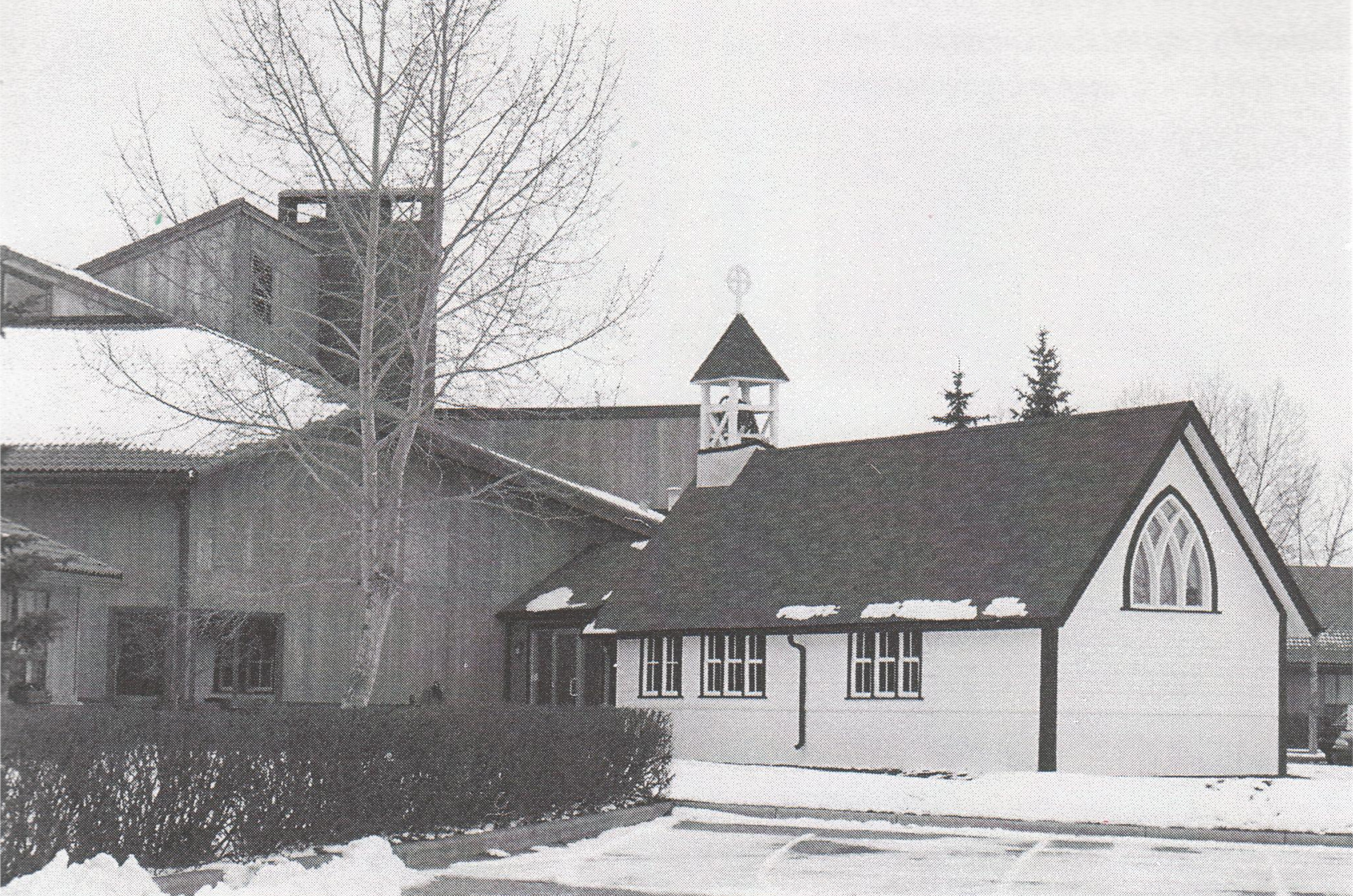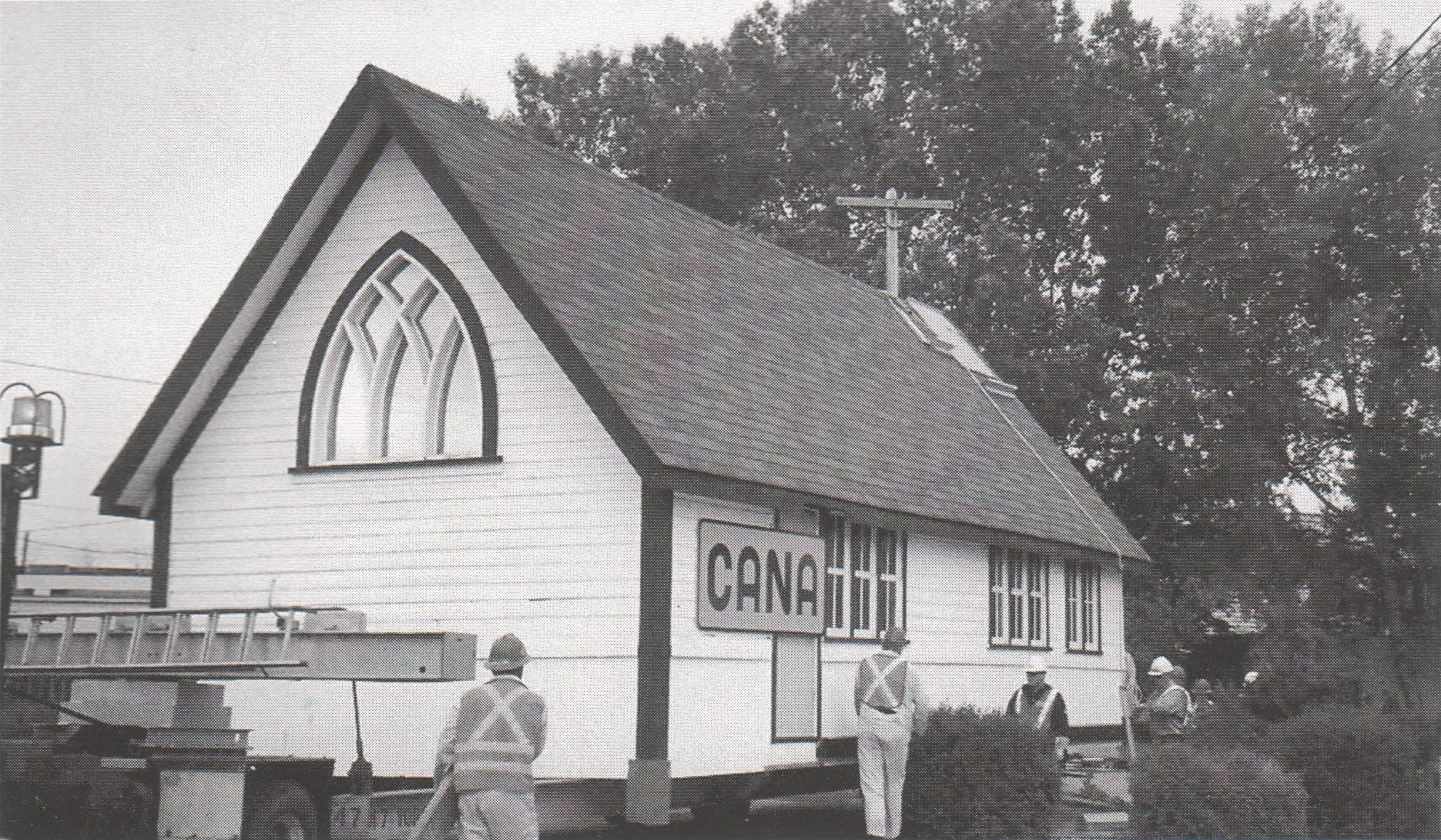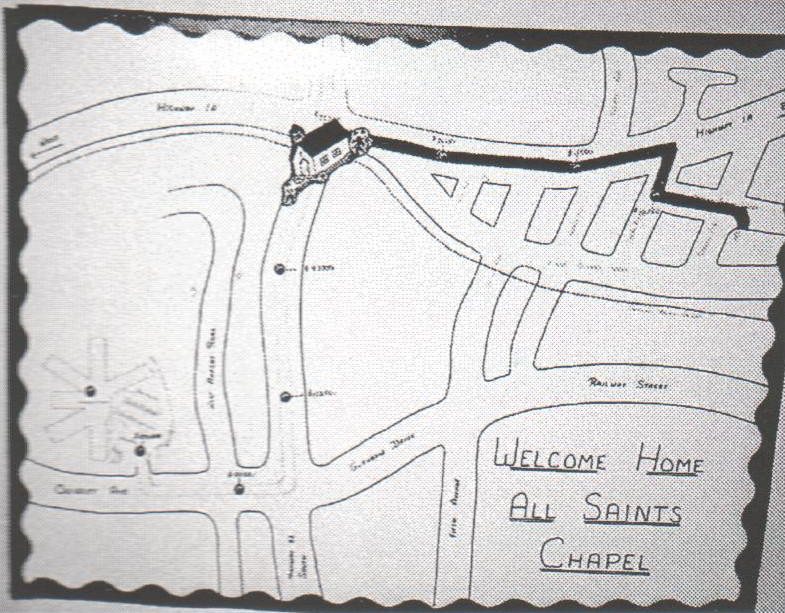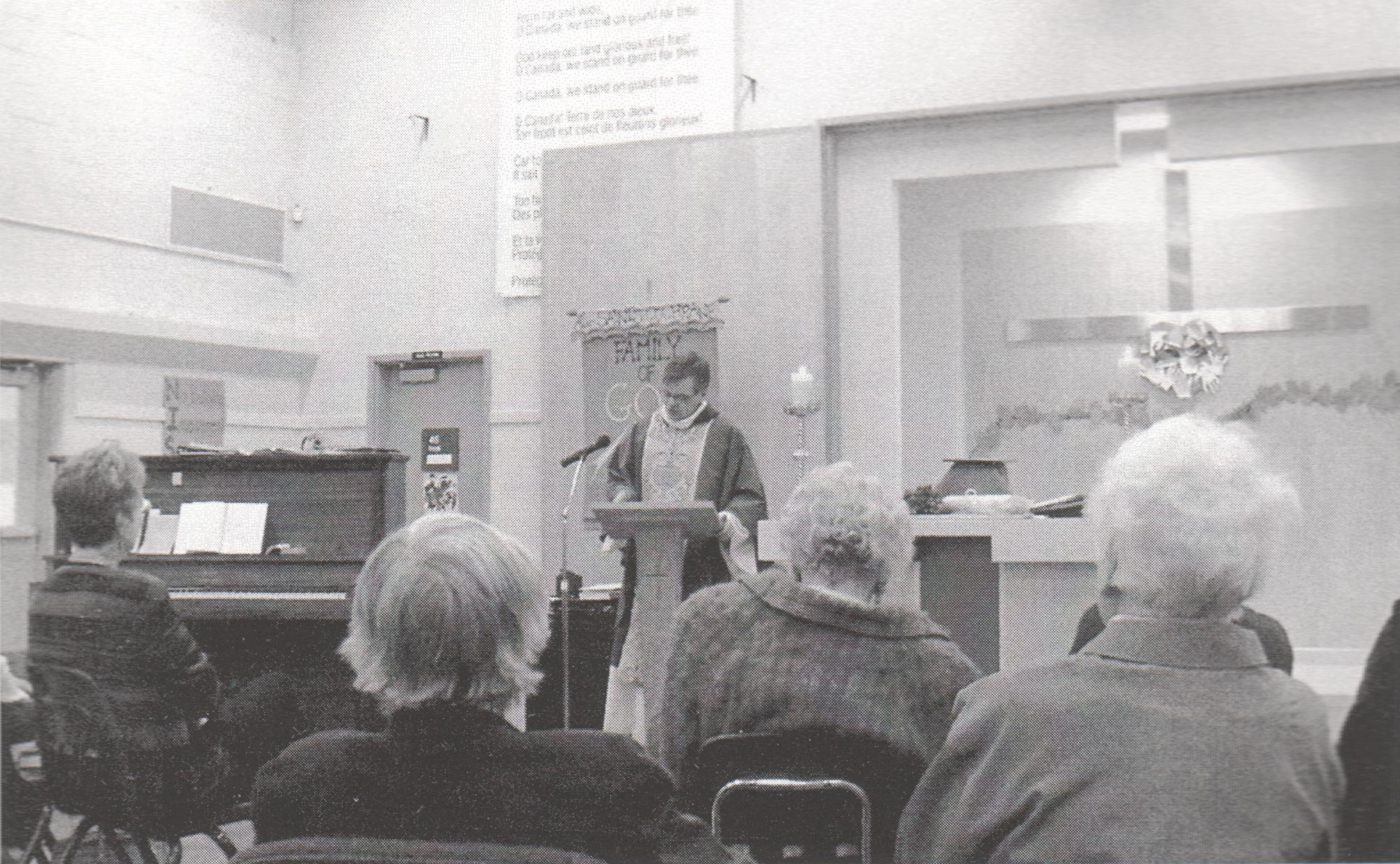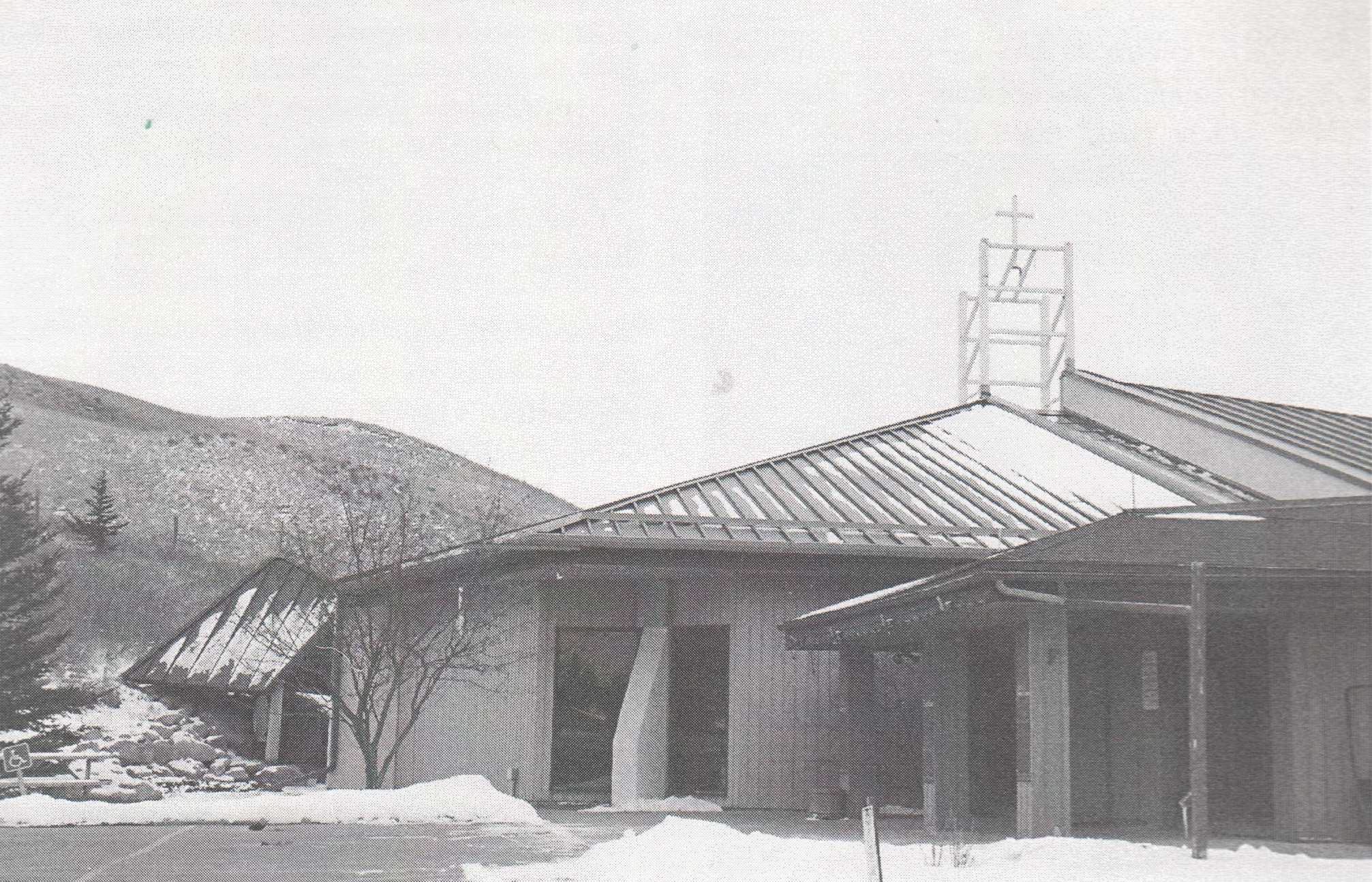All Saints: A History
by Shirley Bays
All Saints Anglican church, which today stands adjacent to the Bethany Care Centre in the West Valley area of Cochrane, is one of Cochrane’s oldest surviving buildings.
In its 114—year history, All Saints church has moved not once, but twice; the first time in 1899 and most recently in 2004.
This is an account of the church’s journey from its origin in Mitford to where it stands today, still playing a significant role in the community.
In 1887, an enterprising and colourful English couple, Lady Adela Cochrane and her husband, Thomas Cochrane, founded the little hamlet of Mitford, three miles west of where Cochrane now stands, on a picturesque bend of the Bow River.
Thomas Cochrane was the son of Admiral Sir Thomas Cochrane, and was one of a large number of English 'remittance men' who emigrated to the Canadian north-west back in the early 1880s to try their hands at ranching.
His wife, Adela, was the daughter of the Earl of Stradbroke, and in 1885 the couple moved to the Cochrane area from High River to take up a ranching lease obtained from the government of Canada.
Thomas Cochrane was an enthusiastic entrepreneur with seemingly unlimited optimism, as well as a good source of funds through his well—connected and resourceful wife.
Instead of ranching, he decided to start a lumber mill next to the Canadian Pacific Railway's main railway line in the spring of 1886. Thomas's company, the Calgary Lumber Company, cut timber in the Grand Valley area and near Dog Pound Creek and shipped it to Calgary and other centres by means of the railway.
Thomas and Adela also decided to lay out the site for a new hamlet where Horse Creek meets the Bow River.
After calling it Saw Mill for a while, Cochranes decided to rename the hamlet after Lady Adela’s niece, Mrs. Percy Mitford. As Lady Adela wrote to Canadian Pacific vice-president William C. Van Horne, "Saw Mill is not a pretty name. I think that if this place were called Mitford it would be much better."
Thomas and Adela Cochrane built themselves a family house in Mitford in 1887, and like their neighbours, kept a number of horses and ponies.
They also raised a number of cows, pigs and chickens, and grew many kinds of vegetables in their garden there.
Over the next few years, the indefatigable (and somewhat over—optimistic) Thomas Cochrane became involved in mining local coal and started a brick manufacturing operation in Mitford using local clay.

By the year 1888, Mitford was a growing community.
Lady Adela hired a school teacher from Ontario to educate local children, and by 1891 Mitford had its own post office, general store, hotel and livery stable. But no community was complete without its own church.
Church services had been held regularly at a private house in Mitford; now the Cochranes made the decision to spearhead the founding of an Anglican parish in Mitford, and the construction of a church.
In 1891, together with ranchers from north of Mitford, Thomas and Adela petitioned Bishop Cyprian Pinkham of the newly-formed Anglican Diocese of Calgary, as follows:
To the Right Reverend Father in God, Cyprian, by Divine Permission, Bishop of Calgary:
The humble petitions of the Rev. W.F. Webb, B.A., Curate—in-Charge, Thomas Cochrane, Lady Adela Cochrane, Robert Cowan, Frank White, W.D. Kerfoot and others resident of the mission district of Mitford, Alberta, N.W.T., whose names and signatures are hereunto subscribed, for themselves, and in the name of the members of the Church of England in Rupert’s Land residing in and around Mitford... members of All Saints Congregation, within Your Lordship's Diocese and jurisdiction, Showeth:
That a certain parcel of land containing half an acre, as fully described in deed of same, has been given absolutely and entirely by Thomas B.H. Cochrane, and William Brabizon Lindsay Toler, Earl of Norbury, Trustees of the Canada Northwest Coal and Lumber Syndicate Limited, for purposes of a burial ground and erection of a church in connection with the Church of England in Rupert's Land, and are desirous to have it set apart from all profane and common use whatsoever.
Bishop Pinkham accepted the petition and sent his handwritten permission. Construction of the new church building began at Mitford in 1892.
The site chosen was above and somewhat northeast of the few houses and commercial buildings that already existed.
This location was fortunate, because it kept the church from being destroyed by fires that eventually consumed Mitford's other buildings.
Lady Adela was a strong personality, and by all accounts every bit as entrepreneurial as her husband. Her independent wealth was probably a great help to Thomas in financing his many business enterprises.
Adela now became the primary source of funds for the new church's construction, and directed fundraising efforts that we would be proud of today.
She arranged a concert in England for the sole benefit of the new church, and appealed to the Society for the Promotion of Christian Knowledge, which gave $96.
Many parishioners themselves donated generously, both their money and skills—again setting the standard for their successors. At a cost of $1500, All Saints church came into being in 1892.
Like other pioneer churches in Alberta at the time, All Saints was a very simple, one-storey, 15 by 30 foot, rectangular, gable—roofed frame structure, with ship-lap wood siding and a steeply pitched gable roof.
But the church building was "distinguished by the quality of workmanship on both its interior and on its exterior" (Alberta Culture Historic Sites Service).
The building rested on a firm foundation of carefully chosen and positioned field stones. The wood, of course, was native wood sawn at Thomas Cochrane's saw mill.
Eleven pews, an altar and a lectern were also built by Thomas. A bell in a bell tower called parishioners to attend services. The multi—paned, stained—glass windows (perhaps coloured glass rather than stained) were shipped to Mitford from England.
Stephen Brisco, a local rancher, inscribed the motto: Cease Not To Give Thanks on a wooden banner which was hung above the altar.
Lady Adela"s friends and relations contributed many of the furnishings, and among the gifts offered by Lady Adela herself were the handsome deacon's bench kept at the back of the church and a fine linen cloth, worked with gold lace and valued at $500.
Other gifts included the beautifully carved bishop's chair given by Mrs. King of the Beaupré district, and a communion set donated by Mrs. Mitford herself. Local ranchers' wives embroidered a white lace communion cloth, and donated candlesticks and altar hangings. Many of these items are still in use today.
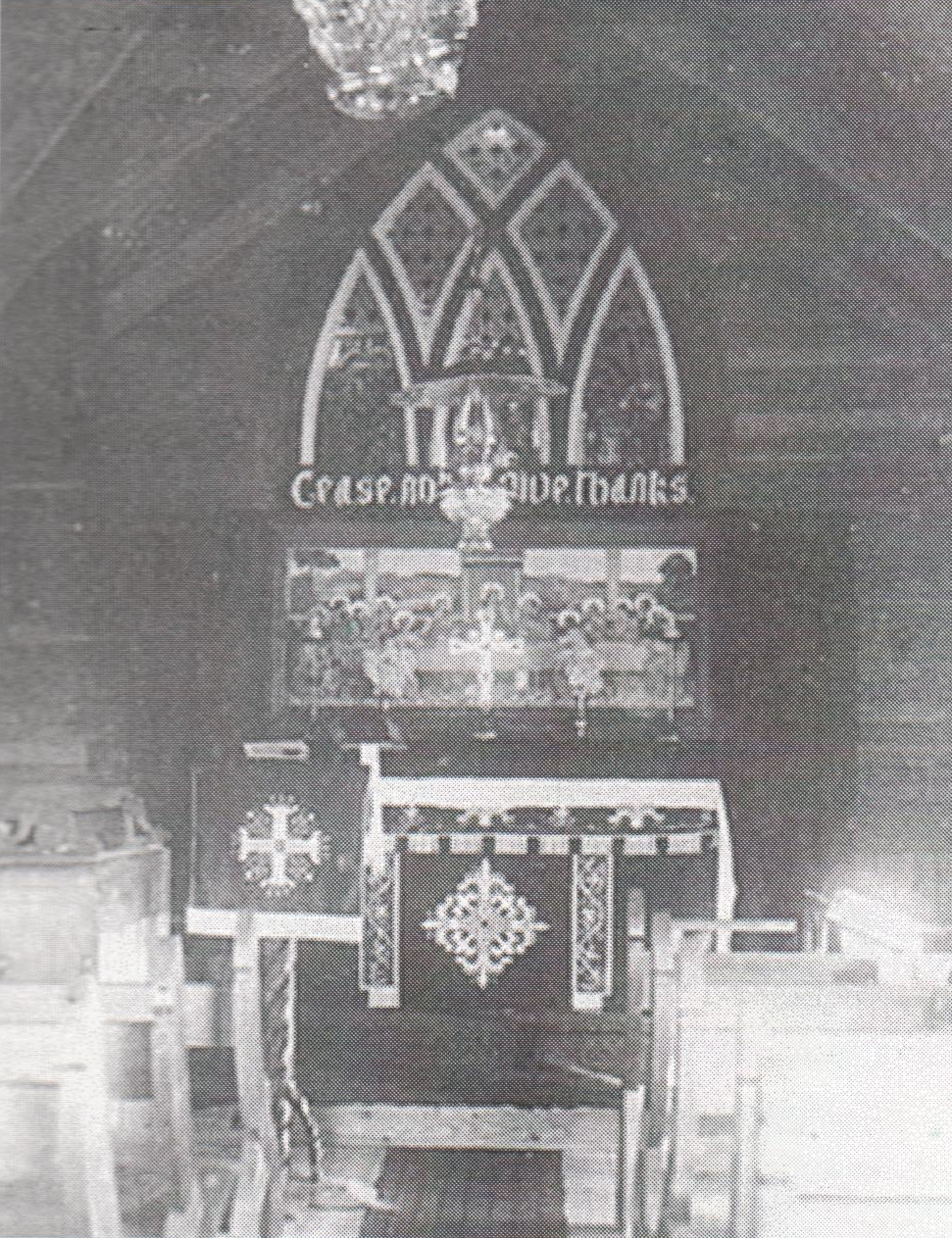
Appropriately, All Saints Mitford was consecrated on All Saints Day: November 1, 1892.
The first incumbent was Reverend W.F. Webb. Among those present at the church’s consecration were Bishop Pinkham, the Reverends Webb and Cooper, and, of course, Thomas and Adela Cochrane.
It was no doubt a proud day both for the Cochranes and for the parishioners, many of whom had come from twenty miles away to attend.
The churchyard was consecrated at the same time and only later surveyed and laid out "in a proper manner for a permanent burying ground." Mitford cemetery continued in use until 1910, long after the church had been moved.
Not much information remains about the church and its role in the lives of the Anglicans of the Mitford area in the first years of the parish. Records were kept in the Minute Book and the registries, and although these date back to 1893. they are regrettably lacking in detail. We do know that the first baptism was held on October 23, 1892, just prior to the consecration of the church, when James William, infant son of Walter and Frances Jones, was christened.
The first Annual Meeting of All Saints Mitford was held in the church at the close of Divine Service on Sunday April 9, 1893 and the first marriage to be solemnized there was that of William Gray and Maggie McMullen on April 23 of the same year.
The only confirmation service ever held at Mitford was on December 1, 1895; while the first burial in Mitford cemetery was that of little Frances Bell-Irving, aged three years, who died on March 21, 1896.
Over the next few years, Mitford continued to grow along the narrow flat between the Bow River and the CPR rail tracks. At its height in the 1890s, Mitford boasted a bridge over the Bow River, a church, a store and post office, a school, a hotel, saloon, livery stable, blacksmith’s shop, and a doctor’s office.
Despite all this, none of Thomas Cochrane’s business ventures was particularly successful. Although Mitford had a good CPR connection for shipping lumber, what the hamlet needed, the Cochranes decided, was a full—fledged railway station and scheduled passenger rail service, to attract more businesses and help Mitford grow. But it was not to be.
The years 1898 and 1899 proved to be fateful years for the hamlet of Mitford. First, a disastrous fire destroyed many buildings, causing a large number of inhabitants to leave. A year later, William Van Horne and the Canadian Pacific Railway decided, in spite of petitions from Thomas and Adela, to create a new train station at the newly established village of Cochrane, just three miles east of Mitford.
The decision was understandable, if disastrous for Mitford.
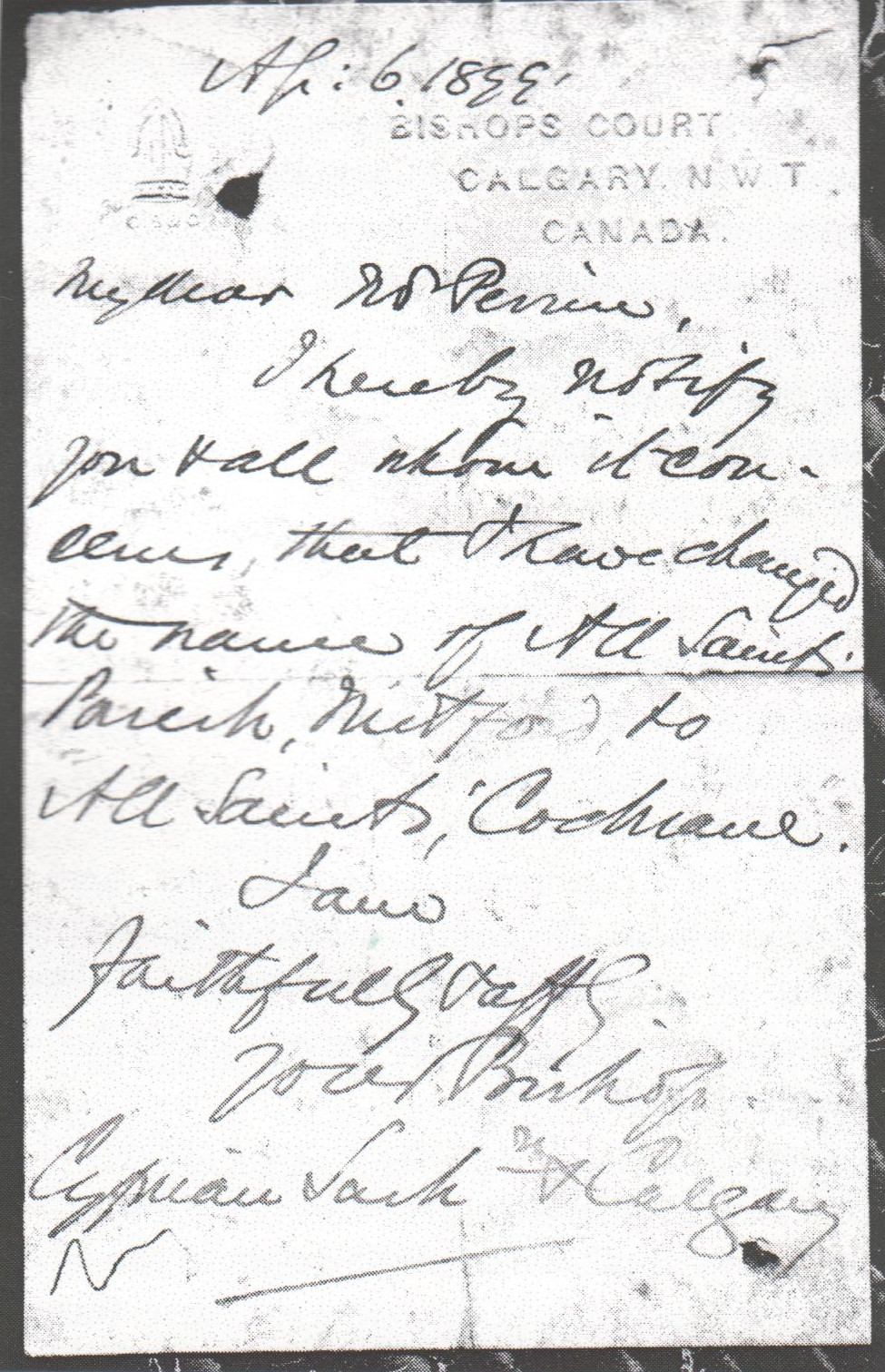
Trains already had difficulty stopping at the hamlet when track conditions were poor, and engineers often found their locomotives held up on the river bridge.
Eastbound trains that stopped at Mitford were often forced to back up in order to get a run at the long, 34°—grade hill east of the hamlet.
The CPR’s decision to bypass Mitford in favour of Cochrane was a huge blow to Thomas and Adela Cochrane. Legend has it that Lady Adela was so furious at the CPR engineers' refusal to halt at Mitford that she stood one day on the railway tracks, facing down an approaching locomotive. For all that she was a shareholder in the Canadian Pacific Railway company and a member of the aristocracy, Adela's courageous protest was in vain. The lady was insulted by the train crew, showered by soot, and nearly run over for her trouble. Although the train crew was ordered to apologize, the CPR engineers did not stop at Mitford again.
Thomas Cochrane closed the saw mill soon afterward, and Mitford was gradually abandoned. After Thomas's unsuccessful bid for a seat in the House of Commons during the elections of 1896, the Cochranes returned to England, where Thomas was offered the position of Deputy Governor of the Isle of Wight.
They never returned to Canada.
The records indicate that the parish of All Saints nearly died along with the hamlet of Mitford. It was one of the last remaining buildings in Mitford. Finances were low, church attendance was poor and no doubt many of the original supporters of the church had already left the area.
At the Annual Meeting on April 2, 1899, the parishioners of All Saints decided, at the urging of their priest, the Reverend W. Eugene—Perrin, to move the church to Cochrane:
The Chairman then stated that since the town of Mitford was dead, and All Saints Church left alone by itself, he had sounded the feeling of the people with regard to its removal to Cochrane; the Bishop had just telegraphed authority for the removal, and the Cochrane Townsite Co. had presented a lot... It was next decided (for the Bishop's approval) that the name of the Parish should he changed from All Saints Mitford to All Saints Cochrane.
The town of Cochrane was not named after Thomas and Adela, as one might assume, but after Senator Matthew Cochrane from Montreal, who initiated large-scale cattle ranching in Alberta, and who established headquarters for his ranch in what is now Cochrane Ranche Provincial Park.
It is ironic that the town of Cochrane bears the name of two people who were bitterly opposed to its establishment. Lady Adela, even from her new home on the Isle of Wight, refused to believe Mitford was dead and was adamantly opposed to the removal of All Saints Church to Cochrane.
No records remain to indicate who was involved in moving the church building, but it was almost certainly volunteers from the parish. Twelve teams of horses dragged the building, on log rollers, to what was to become, in time, the corner of Second Avenue and Second Street in Cochrane.
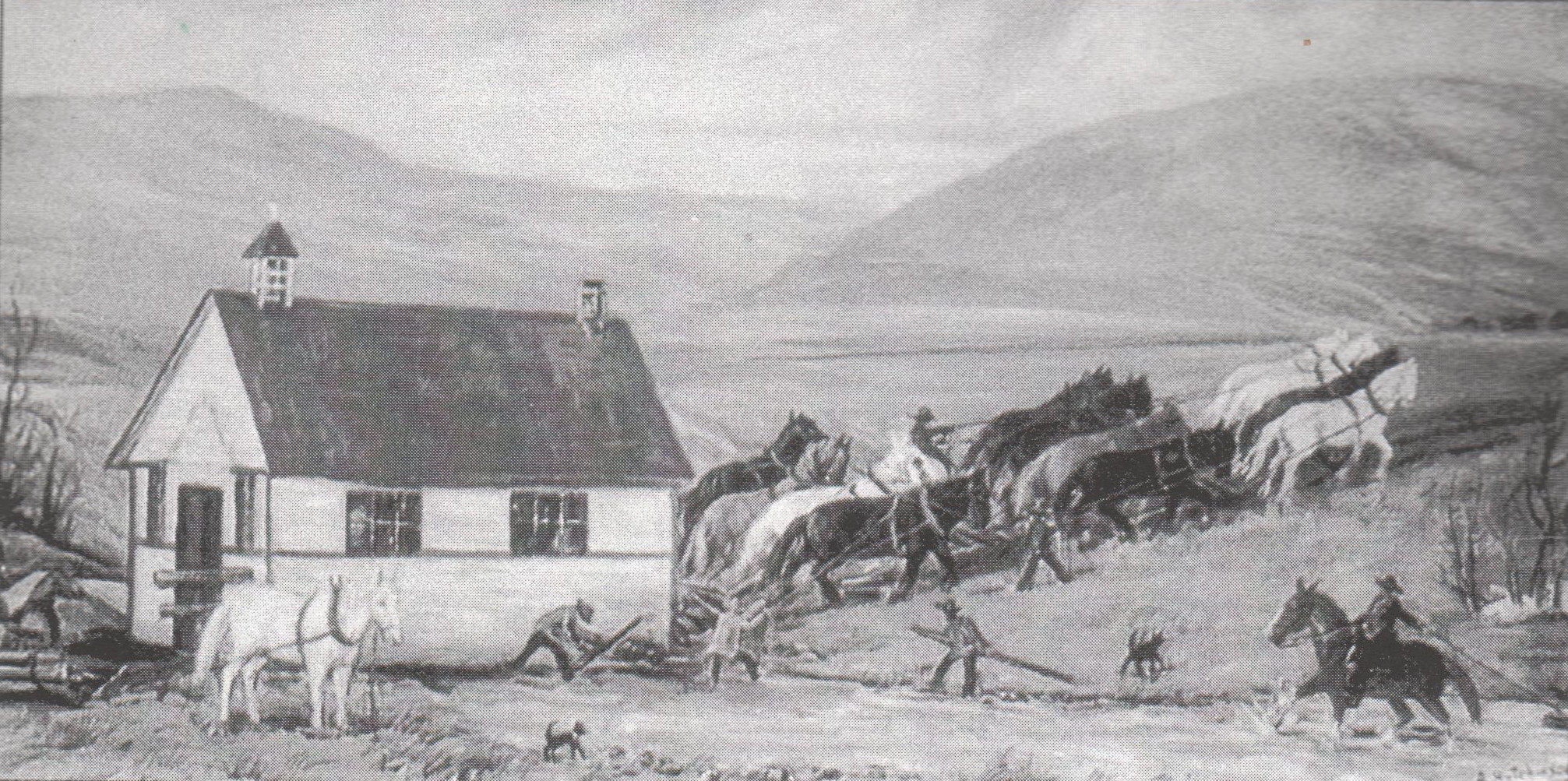
It was a slow, arduous journey. Each log would have been removed from behind the building and placed in front of it as the church rolled over them. One observer related the difficulties involved when the church got stuck in the Big Hill Creek valley.
But in April 1899, only twenty—eight days after the decision to move, thirty-two people braved the Alberta spring weather to attend services at the church’s new location in Cochrane. As the Minute Book reads:
On April 30 His Lordship Cyprian Calgary reopened the Parish Church of All Saints Cochrane...
The smallness of the congregation was owing to a stiff blizzard and snow,; which may be calculated when it is stated that it took Richard Smith and George Reid four hours to come from two miles the other side of the Phipps ranch to attend the baptism of R. Smith's son... The Incumbentd rove His Lordship to Calgary at 4:40, the blizzard still blowing.
In 1899, Cochrane consisted of a few buildings scattered along the main street paralleling the railway line. All Saints church rested, alone except for the small Roman Catholic church already built nearby, on the treeless, undeveloped flat land to the north of the existing buildings.
Following the relocation of the church and the renaming of the parish to All Saints Cochrane, the records show many ups and downs in the finances, attendance and other affairs of the parish through the years.
No records were entered in the Minute Book between 1899 and 1905. In 1905, the parish had no incumbent, but from 1907 onward, services were conducted by a priest who served Cochrane, Exshaw and a number of other communities.
As the population of Cochrane grew and the church became more established, All Saints became home to a Missionary Society, a Sunday School, and an Anglican Church Women’s group, then known as the Ladies' Guild.
The first mention of the Ladies' Guild was made in the minutes of a meeting held on July 30, 1909.
Between 1909 and 1913, many members of the Ladies' Guild (mostly ranchers' wives) left Cochrane. This was likely due to the fact that rural families no longer had to live in the town during the school year now that rural school districts were being established.
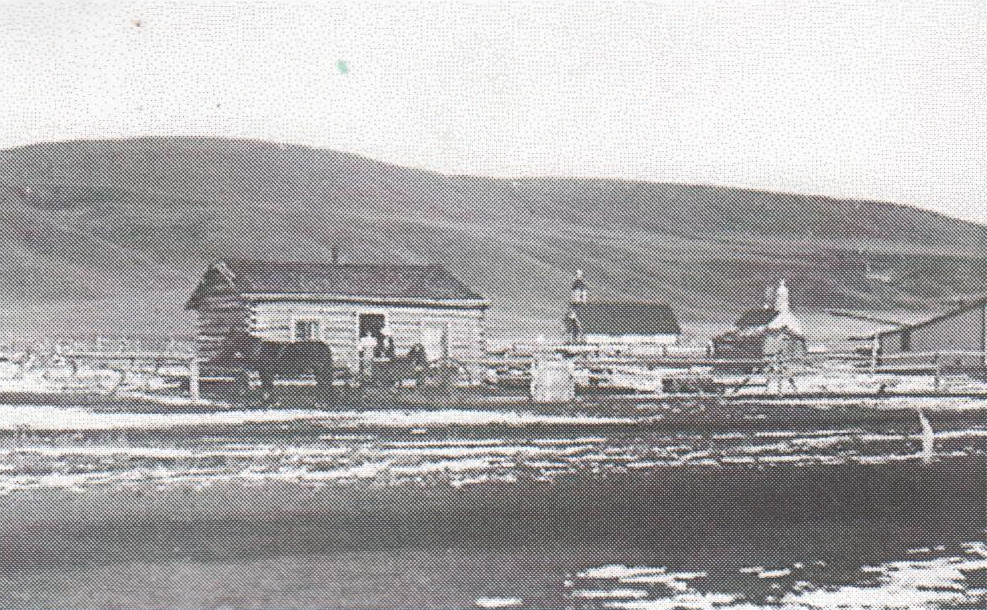
Although women had been an extremely important part of church life from the outset, it was 1908 before the ladies attending parish meetings were allowed to vote on matters concerning their church.
To quote the declaration entitling parish meeting attendees to vote:
Note: Only males, of the full age of twenty-one (21) years, are qualified to sign this declaration.
Luckily, the women's commitment to the church was strong even without representation.
All Saints parish and the wider community of Cochrane suffered many financial hardships in the years following the church's relocation, and it was largely thanks to the efforts of the parish ladies that the church community was able to struggle on. Money had to be found for repairs, insurance, lighting, and the priest's stipend.
Much of the necessary maintenance work was carried out by volunteers from the parish, but many times the Ladies' Guild raised funds to cover church expenses, such as those needed for a stone foundation in 1905, and a much—needed exterior paint job in 1911.
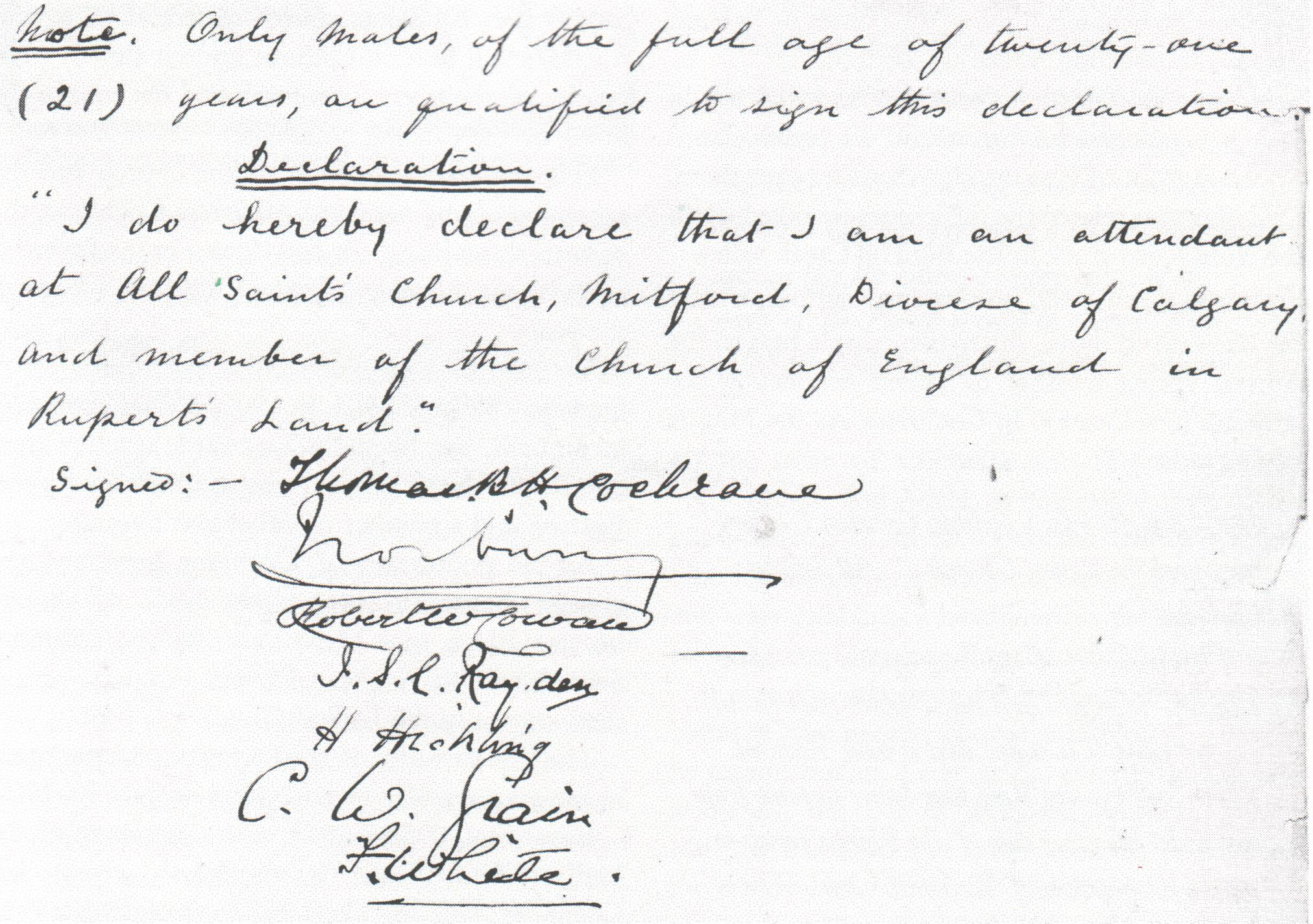
They did this, as they do now, by entertaining: holding 'box socials' (where decorated lunch—boxes were auctioned to the highest bidder), concerts and other entertainments.
Later, the Ladies' Guild even took on the extra cost of insurance premiums, incurred after electricity was installed in the church building.
Times were hard for All Saints and its membership between 1914 and 1930.
The First World War took its toll, as described by the Reverend J.P. Dingle:
1916 was for us a year of just carrying on, and keeping things going. We feel the loss of familiar faces, some removed by death, others away doing their duty. Our church has been hard hit by the war in many ways.
At the 1912 annual meeting it was proposed that electric lighting be installed in the church building, but this motion was rejected by the congregation because the cost was felt to be too high.
Electricity was finally installed in 1914, but from time to time the supply was cut off by the electrical supplier "until further notice" because of unpaid bills.
Not long afterwards, someone proposed that All Saints join other Cochrane churches in holding a Prohibition meeting one Sunday in May 1915. But most of the vestry agreed with Rev. Tyers that Prohibition was not sufficient reason to disrupt Sunday morning services.
During the Depression, parish finances remained in very poor shape.
At the annual meeting of 1929, the books showed a balance of $5.38; in 1930, the balance was a mere $1.43. As usual, any urgent maintenance work was done by members of the parish to save money.
Funds to pay the stipend of visiting clergy, who usually travelled between Canmore, Exshaw and Cochrane, were particularly hard to come by. In 1921, the Church was closed for six months because the parish couldn't afford to pay a priest's stipend. However, the economic situation gradually improved, and in 1933, All Saints was able to increase the priest's stipend from $5 to $6 per month.
In 1939, the Bishop of Calgary announced that All Saints Cochrane would be served by the incumbent from St.Stephen's Anglican church in Calgary, rather than by a priest from Canmore.
This arrangement lasted for the next several years, with services being held every other other Sunday until 1953, when the church was closed for two years, likely because of a difficulty in finding a priest to conduct services in Cochrane.
The Ladies' Guild never ceased to exist, but was officially re-established at All Saints in 1954 as the Anglican Church Women. It was a strong and active organization for many years, contributing greatly to the financial and social needs of the parish.
In June 1956, Cochrane became part of the parish of Exshaw and Canmore, and once a month, services were officiated by the Reverend O. Foster, the incumbent at Canmore.
When the Reverend T.F. Wright took over St. Michaels' in Canmore, services at All Saints Cochrane became more frequent until eventually he was taking regular weekly services, as well as celebrating Holy Communion on saints' days and other occasions.
When Rev. Wright retired in 1965, it was another Calgary clergyman who again took up the reins.
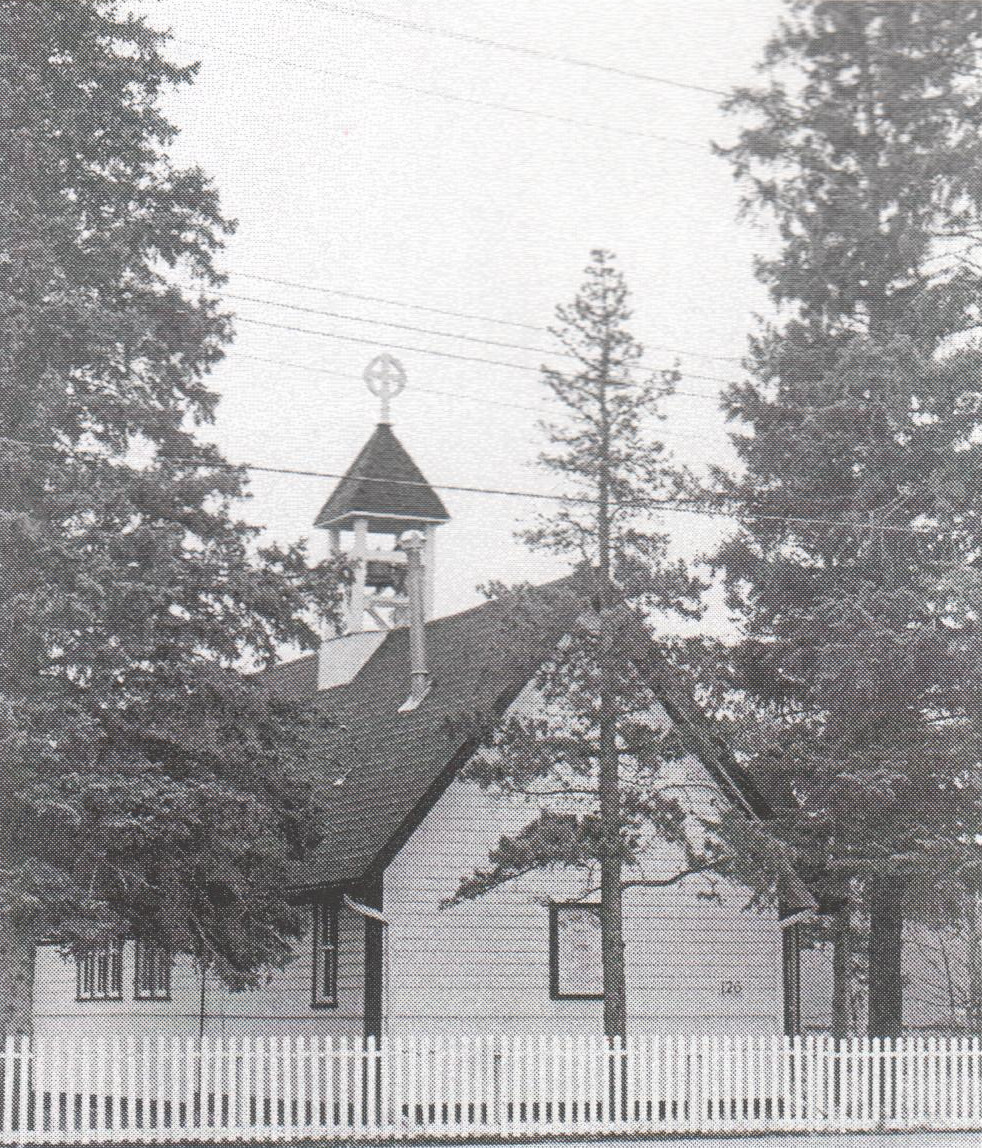
By 1963, there were some 70 families on the parish roll and a Sunday School had been re-established.
The parish budget rose from $300 to $2,500, and many improvements were made to the church. A gas line and a new gas furnace were installed, the wood floors were sanded and refinished, a carpet was laid, and the exterior was repainted.
The Cochrane Masonic Lodge presented an organ to the church in 1958.
It was not until 1966 and the decision to invest in a rectory that the parish of All Saints Cochrane finally acquired its own incumbent priest.
A rectory for the incumbent had often been the subjecr of debate among vestry members. In 1909, for example, a motion was passed at the parish annual meeting to secure a lot on which to build a parsonage.
The construction of a parsonage was again proposed in 1913, "to cost not more than $500", and to be such as could be "worked into a permanent house". Although this last motion was carried unanimously, in fact the parsonage was never built—why, we don't know.
Finally, in 1966, a rectory was purchased, and the Rev. Douglas Blackwell and his family moved into 110 Cochrane Crescent.
Subsequent occupants of the rectory were the Rev. Alan Howes (1970-72) and Canon Leonard Hill (1972-1978). Canon Hill's widow, Frances, is still a parishioner at All Saints today.
In 1978, the parishioners had a mortgage-burning ceremony when the rectory was fully paid for, and put the torch to the last bill.
The Reverend David Asher followed Canon Hill in December 1978 as a deacon, and then remained in Cochrane as priest-in-charge from 1979 through 1981.
Bishop Douglas Ford arrived in October 1981, having recently retired as Bishop of Saskatoon.
He and his wife, Doris, remained in the rectory during the four years of his incumbency.
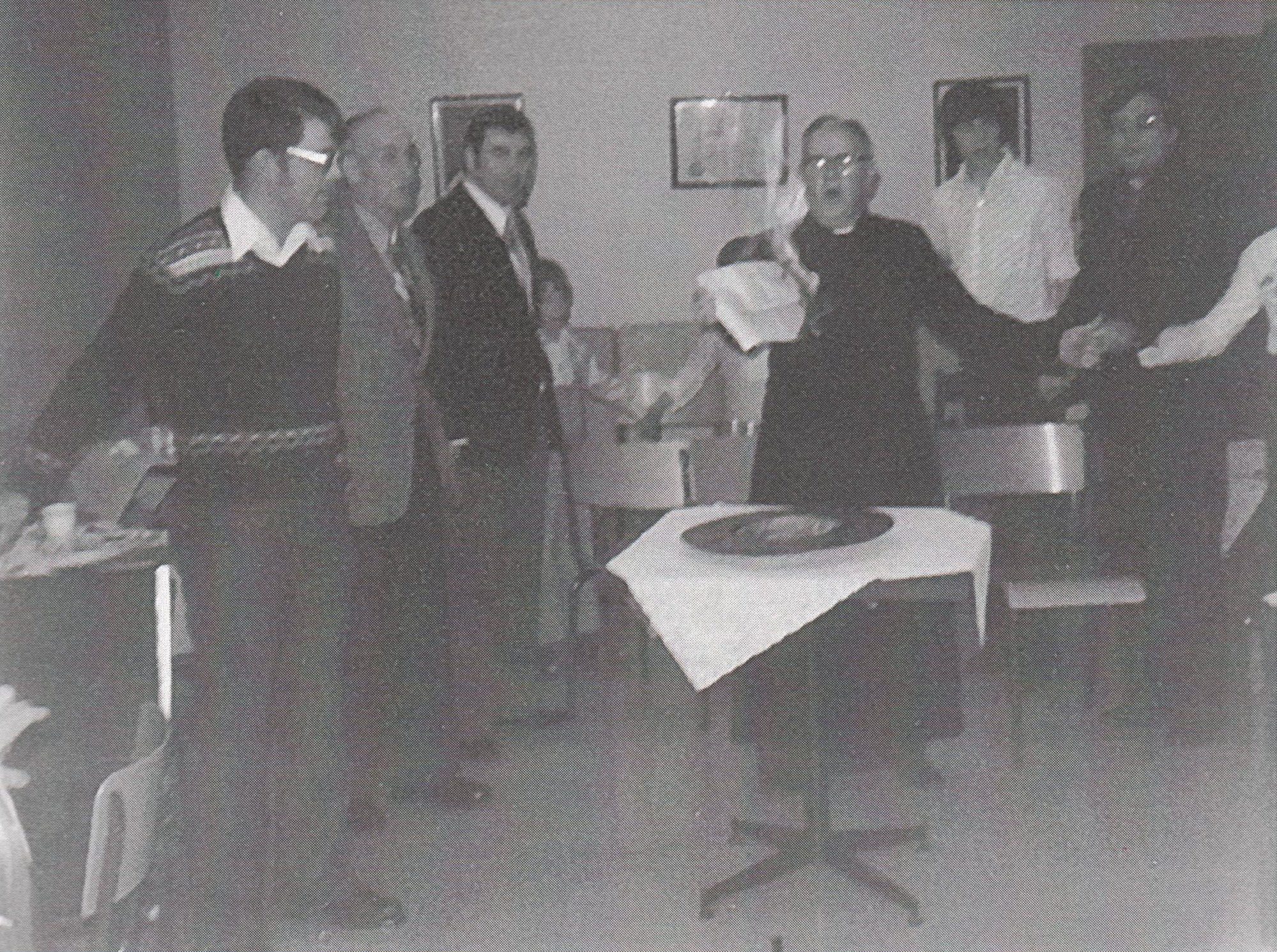
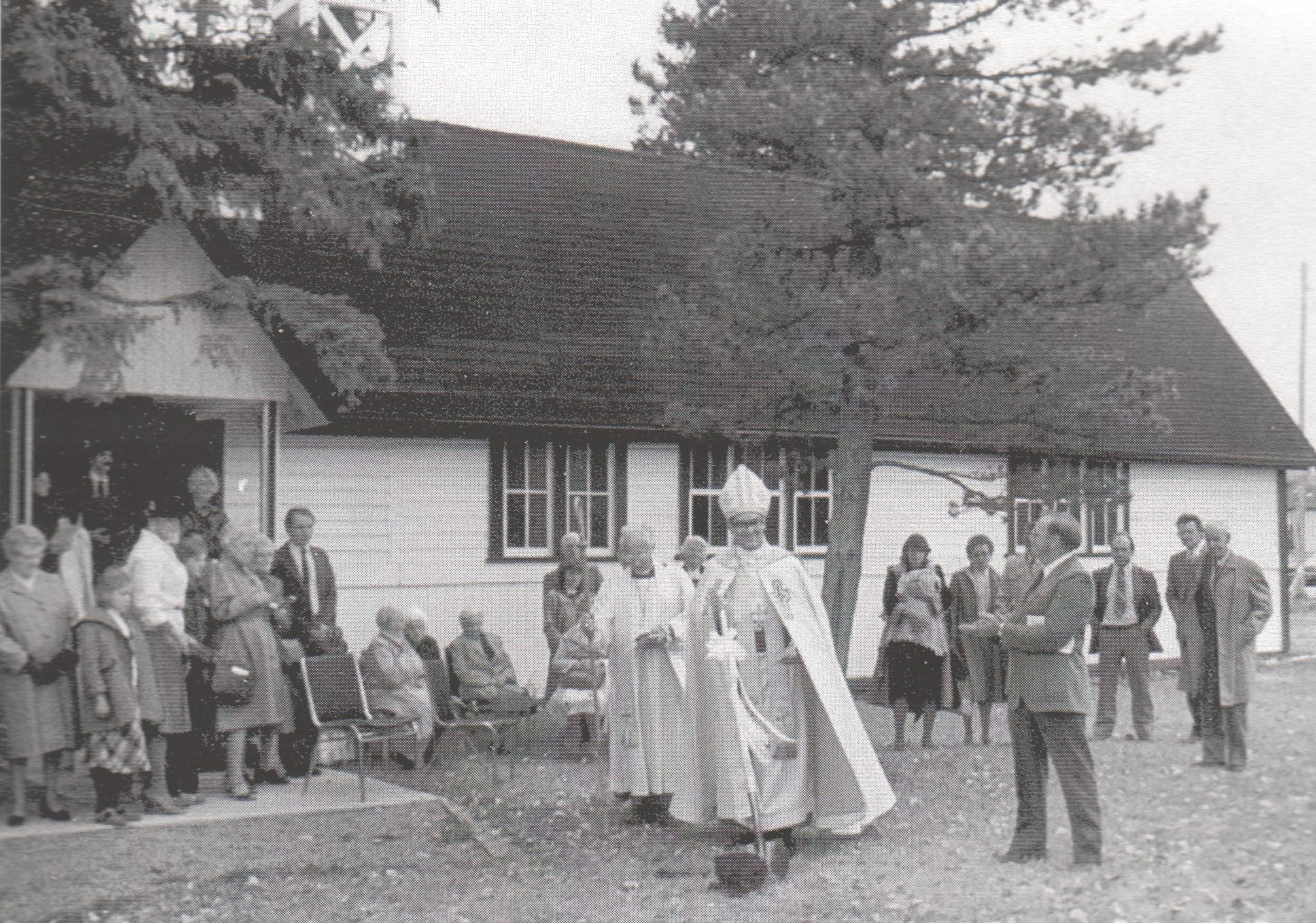
A much—needed parish hall was built onto the original church structure in 1984 during Bishop Ford's tenure. It was named Ford Hall in his honour.
Succeeding Bishop Ford in 1985, the Reverend Richard Lemmon served All Saints as parish priest until 1990, when the Reverend Derek Dunwoody came to us from Ireland, via Winnipeg and Didsbury.
Since the rectory was not needed by Dunwoody, it was sold and the proceedings were put into a Diocesan trust fund for future use.
Derek Dunwoody’s focus during his incumbency was to introduce parishioners to some of the ideas of more modern Christian thinkers and to some of the ways in which the Anglican Church is evolving.
In 1992, the members of All Saints celebrated the 100th anniversary of their church's consecration.
In true Anglican style, the celebrations kicked off with a pancake supper at the Cochrane Community Hall, followed by a wonderful dinner and a special service of commemoration with plenty of soul-inspiring music.
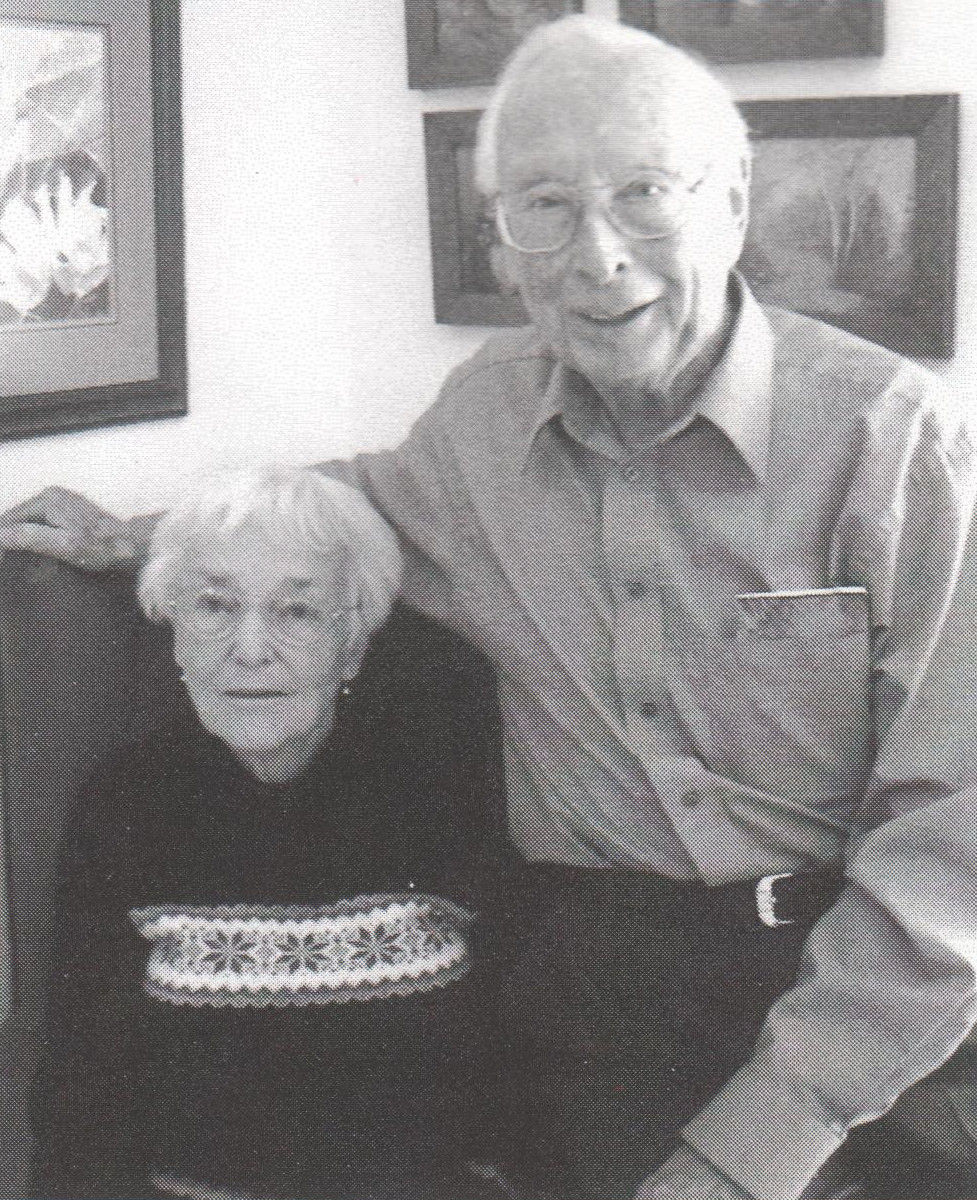
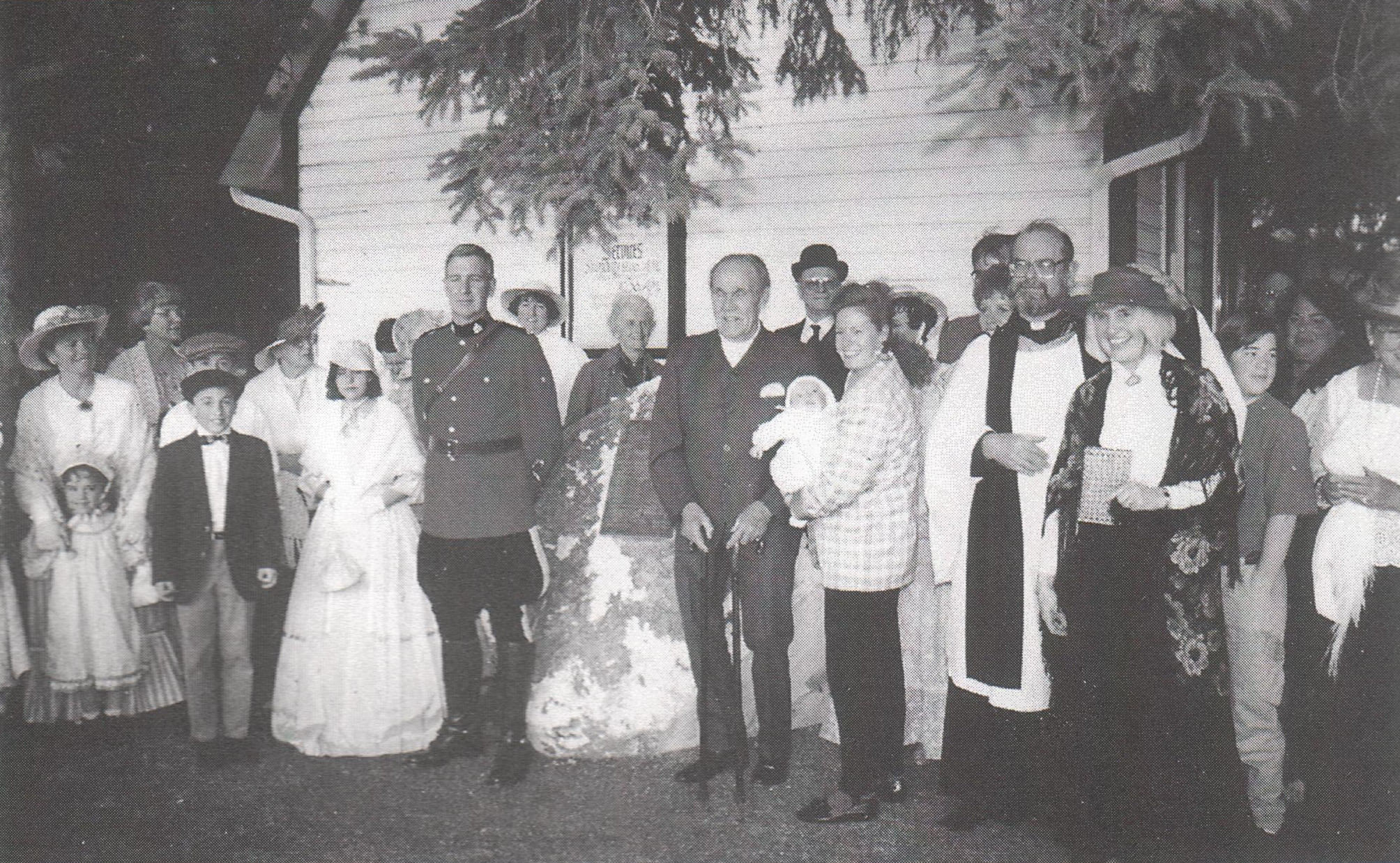
It was soon after this milestone that the congregation and vestry members decided to work with a consultant to help them re-examine the parish's mission and role in the community.
After exhaustive discussion, several surveys, and many evening meetings at parishioners' homes, the congregation envisioned All Saints as "a thriving and expanding Christian community, embodying God's welcoming presence and offering healing, hope and inspiration to those who seek them."
In 1999, All Saints celebrated another centennial, the anniversary of the church's 'rebirth' as the Anglican parish church of Cochrane.
Over the previous hundred years, the little 15 X 30 foot building had become a focal point of downtown Cochrane, one of the oldest surviving buildings in a town whose population now exceeded 10,000.
Although the church still served a thriving community, its small size had become problematic, making it difficult to grow, or even celebrate those occasions (such as weddings and funerals) that are part of the life of any church community.
Many ideas to overcome the space problem were considered, including building on to the existing church or buying land on which to erect a new facility, but nothing came of these ideas despite many attempts to reach a consensus.
After ten years of service, Derek Dunwoody left All Saints in order to retire in 2001.
Several interim priests filled in for many months and became an integral part of our parish until the current incumbent, the Reverend Greg Clark, became our new priest in September 2002.
A solution to the problem of All Saints' growing congregation came in 2004, when the members of Cochrane's Roman Catholic church, St. Mary's, decided that they, too, had outgrown their church building, and offered our congregation the opportunity to purchase their beautiful facility up the hill on 5th Avenue.
After making the decision to move, the parishioners of All Saints decided that, if possible, their historic little church building should stay in the community of Cochrane and continue to function as a sacred space.
These wishes were fulfilled when representatives from Cochrane's Bethany Care Centre expressed a need for a place of worship for the elderly residents
With support from the Anglican congregation, the Bethany Care Foundation and the Town of Cochrane, our small wooden church was moved once more, not by a team of horses this time, but by transporter truck, to its new home as chapel for the Bethany Centre on Quigley Drive (in fact, not far from its original location at Mitford).
At the Bethany, our church continues to serve as a cherished place of spiritual reflection for people of all faiths among residents, staff and the wider community.
The congregation of All Saints has been worshipping in the gymnasium of Holy Spirit School for over two years, in anticipation of the move into our future home up the hill.
During this time of transition, the congregation has continued to reflect on the kind of church it wants to be within the thriving community of Cochrane. At the start of the new millenium parish members came to the conclusion that people are looking for a base community to help them live more meaningfully and humanely in their families or household units, as well as within the larger society.
The church’s ministry is dependent on becoming just such a community, and today All Saints continues to work toward that vision.
Sources included:
- Big Hill Country (Jo Hutchinson)
- Cochrane and Area Heritage Association
- Alberta Culturual Historical Resources, The Calgary Herald
- Cochrane Historical & Archival Preservation Society (CHAPS)
